
Original Link: https://www.anandtech.com/show/1761
ATI Radeon 9600 Pro Mac & PC Edition: One Card for All
by Anand Lal Shimpi on August 19, 2005 12:54 PM EST- Posted in
- Mac
When I first started using Macs alongside my PCs I was quickly reminded of how similar the two platforms had become in terms of their actual hardware. Honestly, with the exception of the PowerPC CPU and custom chipset/motherboard, the inside of my first G5 looked hardly any different than a very well built PC. It used a plain old SATA hard drive, a DVD drive, the same DDR memory and even the same GPUs.
Of course, there were some limitations; I couldn't just throw in the gigabytes of DDR memory that I had laying around. I needed G5 compatible modules that adhered to Apple's strict SPD programming requirements. But after locating some, I could use them on both Mac and PC platforms, albeit their slower timings made them mostly undesirable for use on any of my PC test beds. The use of Mac compatible video cards wasn't as multifaceted, however. Although the Mac cards shared the exact same GPUs that I had been used to on the PC side of things, the cards were sometimes physically different and always featured a Mac-only firmware. You could stick a Mac card in a PC, but it wouldn't POST, not without a firmware reflash; and the same applied in reverse as well.
It turns out that making a universal Mac and PC video card isn't that tough. It's just that there are some implementation details that had to be worked out before doing so. One of the biggest problems ended up being Apple's powered ADC connectors that were featured on the previous generation of their Cinema Displays. The ADC standard calls for video, USB as well as power for the monitor to be sent over a single cable from the video card to the monitor. Generally speaking, drawing enough power to drive a 23" Cinema Display takes a little more than what can be delivered over a standard AGP slot, especially if the slot is tasked with powering the GPU as well.
Apple's solution to the problem was to outfit ADC enabled cards with a separate connector to feed a 25V line to power any monitors and USB devices connected to them over the ADC port. The problem is that no PC motherboards feature support for this additional connector and an ADC connector isn't too useful for most PC users. But with Apple's move to DVI for their latest monitors, suddenly there's a lot more in common between PCs and Macs and their video card requirements.
NVIDIA's GeForce 6800 Ultra DDL was essentially identical to the PC 6800 Ultra card, but without the need for external power, so the card featured a considerable amount of additional circuitry to pull power from the motherboard instead. But other than that difference, the Mac card looked like just any other dual-DVI PC graphics card, except it would only work in G5s.
So, when ATI set out to make a retail 256MB upgrade product, they figured the requirements had conspired in favor of bringing a Mac and PC compatible card to the market; thus, the ATI Radeon 9600 Pro Mac & PC Edition was born.

The Card
As its name implies, the Radeon 9600 Pro Mac & PC Edition is a single card that will work in both Macs and PCs. The dual compatibility is made possible with only a single ROM chip loaded with both sets of firmware. The card actually boots as a PC card, but if installed in a Mac, the OS will override the PC firmware and start it up as a Mac card. On a PC, the system isn't at all aware of the Mac firmware present.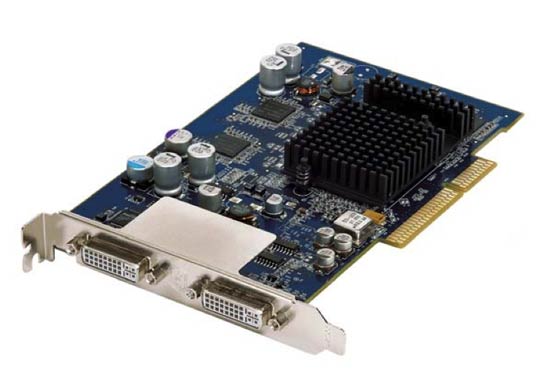
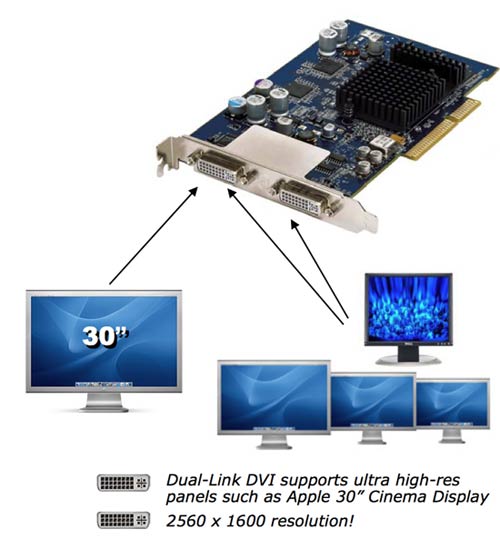
With the RV350 GPU at its heart, the Radeon 9600 Pro Mac & PC Edition isn't a card for those looking for ridiculously high frame rates in games. Instead, it is for those users who want a video card for everything but games. In particular, the 256MB frame buffer of this card is one of its biggest selling features. At the 2560 x 1600 native resolution of the 30" Cinema Display, 256MB of local frame buffer is necessary to avoid swapping to system memory when you have a lot going on in OS X. In fact, the general UI performance of the 256MB Radeon 9600 Pro Mac & PC Edition is identical to that of a Radeon X800 XT Mac Edition, even when running on a 30" Cinema Display at native resolution. So, for those who don't need the gaming performance of a X800 XT, the new 9600 Pro gives you the same 256MB of memory, but at a lower price point.
Like ATI's other 96xx Mac offerings, the 9600 Pro Mac & PC Edition is entirely passively cooled, and thus, is silent. It is quite surprising how much of a difference a GPU fan can make to the overall noise output of a stock G5 system, but it does make a major difference.
ATI is pricing the 9600 Pro Mac & PC Edition at $199, which is rather expensive for a 9600 Pro; the primary reason for the premium is due to the 256MB of memory. ATI is hoping that retailers will stock this new dual function card much like the rest of their cards; thus, giving everyone easy access to it. Given ATI's prevalence in retail stores like Frys, Best Buy, Future Shop and CompUSA, we wouldn't be too surprised to find the Radeon 9600 Pro Mac & PC Edition on those stores' shelves in the near future.
The Test
Despite the fact that the Radeon 9600 Pro Mac & PC Edition doesn't use the most desirable gaming GPU in the world, we have to evaluate its performance as one to see exactly where it falls in the grand scheme of things. PC users can look back at any of our Radeon 9600 articles to get an idea of the performance of the GPU in PC games, as this performance comparison will only focus on Mac platforms.For our test bed, we used a Power Mac G5 with dual G5 2.0GHz processors and 1GB of OCZ DDR400 memory. We used a Dell 2001FP with the desktop resolution set to 1600 x 1200. The system was running OS X 10.4.2 with all of the latest updates installed as of today. The only extra software installed was ATI's control panel, which ships with the Radeon 9600 Pro Mac & PC Edition (both the Mac and PC software is included in the box on two separate CDs).
ATI's Mac control panel lets you configure quite a bit, especially with regards to flat panel display options:
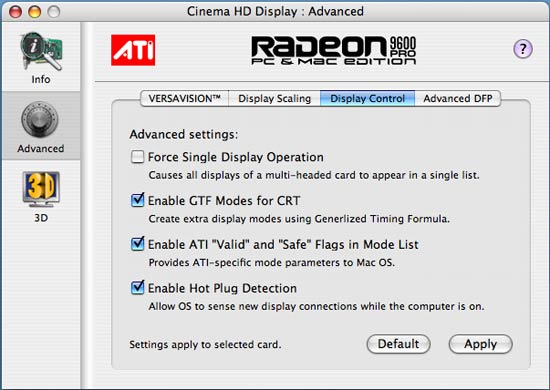
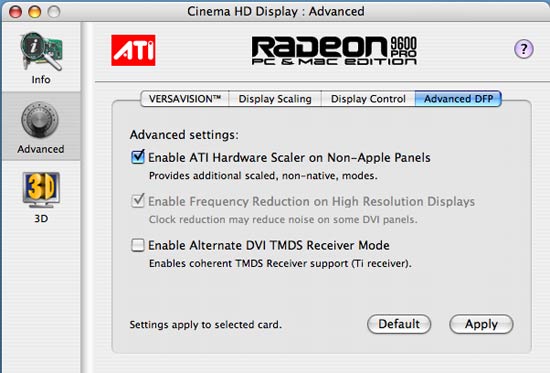
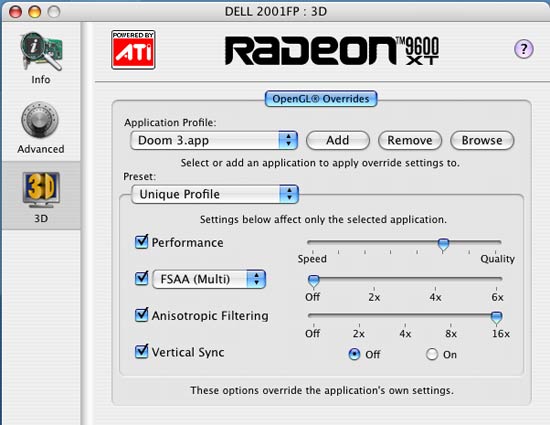
UI Performance
Mac OS X relies on a fully OpenGL accelerated GUI to, in a sense, make things look pretty (and enable features like Exposé). But despite what you may think, the majority of UI performance is still dependent upon the CPU. Until Apple enables Quartz Extreme 2D in Tiger, all UI elements are CPU rendered and, with the appropriate GPU, are simply treated as AGP textures and composed on the GPU itself. Although the majority of the work is still done on the CPU, there is an element of GPU interaction that can impact performance.In order to measure the GPU's impact on overall UI responsiveness, we turn to XBench, a synthetic test that can give us a slight idea of UI performance. The three tests that we focus on are XBench's Quartz, OpenGL and UI tests. The latter is possibly the most important to UI performance, but all are interesting.
The Quartz test focuses on Quartz rendering performance and is mostly CPU bound, but as we mentioned earlier, there is a slight impact of graphics performance. More than anything, we're looking at driver maturity here, since the test uses almost 100% of the CPU (it is only a single threaded test).

The OpenGL performance test is more of a primitive 3D test than anything else. It doesn't really impact UI performance at all - it's more of a basic texturing test as it makes no use of complex shaders.

The most interesting test is the UI test, which basically tests multiple UI elements and scrolling performance under OS X.

The rest of the ATI solutions perform basically identical to one another, with the Radeon 9600 Pro Mac & PC Edition falling to the bottom of the list.
With the synthetic benchmarks out of the way, let's look at some games...
Doom 3 Performance
The Mac version of Doom 3 was finally released, a lot later than expected, but it provides us with a truly modern game engine on which to test performance.Unlike the PC version, Mac Doom 3 is far less of a performer, even when paired with an X800 XT or GeForce 6800 Ultra DDL. There's been much discussion as to why, but it looks like there are a number of factors that contribute to very poor performance of Doom 3 under OS X. The fact of the matter is that while a GeForce 6800 Ultra would be more than capable of running Doom 3 smoothly at high frame rates on a PC, the same cannot be said even at the lowest resolutions on the Mac platform.
We ran all tests at High Quality settings, using Doom 3's built-in demo1 timedemo.
With our expectations appropriately set, let's look at the performance breakdown:

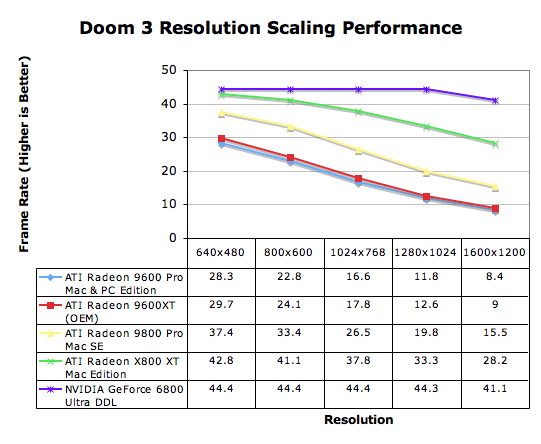
Unreal Tournament 2004 Performance
Our UT2004 test is a Flyby of DM-Antalus, the same test that was used under UT2003.Flyby performance ends up giving a better look at pure GPU performance as it removes all of the physics and AI calculations that the CPU would normally be performing. So, while you get higher frame rates, you still end up finding out which cards are the fastest.
We used Santaduck's UT2004 Benchmark Toolkit at its Maximum Quality Settings for all tests.

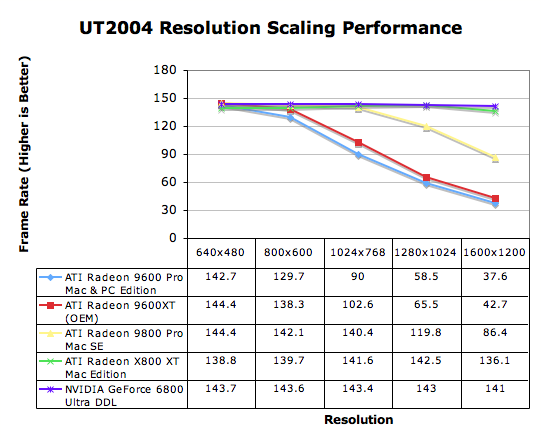
Halo Performance
For our Halo tests, we left all settings on default and enabled Advanced Pixel Shaders: 
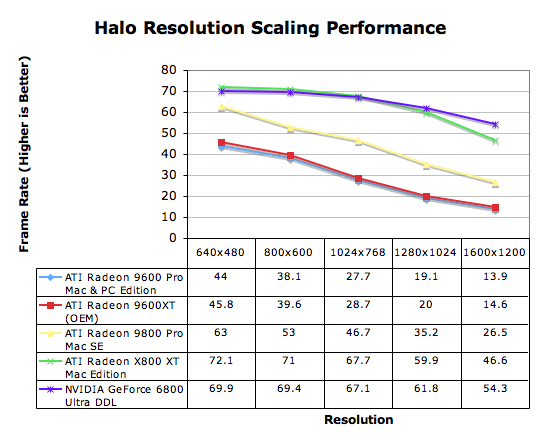
Application Pixel Shader Performance
For our last tests, we have two applications that use pixel shaders and thus GPU acceleration, Apple's Motion 1.01 and iMaginator 2.0.Motion is Apple's motion graphics software package and many of its effects are rendered on the GPU. For this particular test, we use the Motion Mark RAM Preview test described here.

Next up, we have iMaginator 2.0, a image processor that uses OS X's Core Image framework to apply GPU accelerated filters and other effects to images. For these tests, we standardized on the benchmarks introduced by Macwelt. The three tests used basically combine a number of filters and play 200 frames of their effects with a 0-second delay between frames, timing how long they take to play back.
Test 1 performs the following filters in this order: Kaleidoscope, Bump Distortion, Bloom, Bloom, Glass Distortion, Glass Distortion, Transition: Mod. Our test 1 is slightly different than what was introduced by Macwelt.



It is interesting to note that in Test 1, the 256MB frame buffer of the Radeon 9600 Pro Mac & PC Edition actually gave it a significant advantage over the 128MB Radeon 9600XT, despite the fact that the 9600XT has more memory bandwidth.
Final Words
As a card, the Radeon 9600 Pro Mac & PC Edition is an excellent offering. If possible to do without significantly driving costs up, we'd like to see Mac & PC compatible offerings of all of ATI's GPUs, ideally even doing away with discrete Mac and PC products and replacing them with a line of cards that just work regardless of platform.What ATI has done with the Radeon 9600 Pro Mac & PC Edition is bring forth a 256MB card that offers a silent solution for those users wanting to move to a 30" Cinema Display. The actual OS X UI performance of the card is just as good as ATI's top-of-the-line X800 XT. So, unless you are playing any games or running any applications that make extensive use of pixel shaders, the Radeon 9600 Pro Mac & PC Edition is a very functional card to pair with a 30" display. The biggest draw in our opinion is the card's passive cooling; combine that with its 256MB frame buffer and you have a pretty decent solution for OS X users.
Unfortunately, once you fire up a game or applications like Motion or iMaginator that actually depend on good pixel shader performance, the Radeon 9600 Pro Mac & PC Edition starts showing the age of its GPU. Honestly, for $200, we'd expect something closer to the entry level X800s or even the X700 Pro in terms of performance, not a two-year-old Radeon 9600 Pro. While ATI is making great efforts to bring equality between Mac and PC platforms by releasing a universal card like this one, by doing so on such a old and, by today's standards, underperforming GPU platform doesn't really help all that much.
So, while the Radeon 9600 Pro Mac & PC Edition is useful, it is not the product that we're dreaming of. It is a fine solution for those users who are still running non-GPU accelerated applications, but not too useful beyond that.
Alongside the release of the Radeon 9600 Pro Mac & PC Edition, ATI is also changing around their retail Mac product line, as you can see from the slide below:
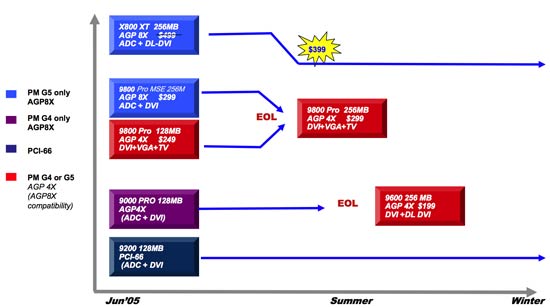
Then, of course, there's the 9600 Pro announced today at $199, which should be available shortly.
What's important to note here is that other than the entry level Radeon 9200, all of ATI's Mac Retail products will feature 256MB of memory. And the mid-range cards will have completely done away with ADC connectors in favor of dual DVI or DVI + VGA. While ATI has not announced any plans to bring any of their 512MB cards to the Mac market, we'd expect them to do so sometime next year.







